Sexy German dancer and film actress La Jana (1905-1940) is a mysterious legend of the German cinema. In the 1940s, she was the most popular showgirl of Berlin and she appeared in 25 European films, often dancing in exotic costumes. In 1940, Goebbels sent her on tour for the Wehrmacht and while dancing half-naked in the cold, La Jana got ill and died of pneumonia and pleurisy.
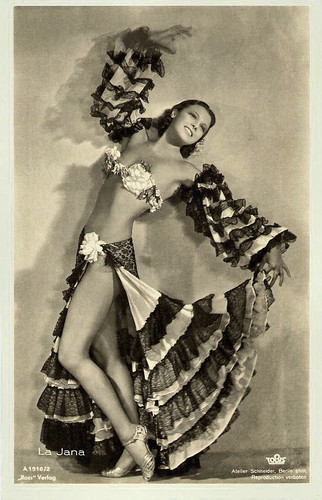
German postcard by Ross Verlag, no. A 1910/2, 1937-1938. Photo: Atelier Schneider, Berlin / Tobis.

German postcard by Ross Verlag, no. A 1589/1, 1938-1939. Photo: Eichberg-Film. Collection: Didier Hanson.
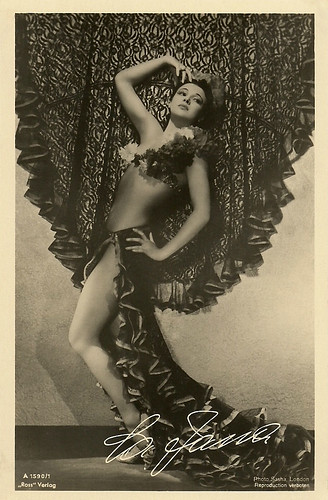
German postcard by Ross Verlag, no. A 1590/1, 1937-1938. Photo: Sasha, London. Collection: Didier Hanson.
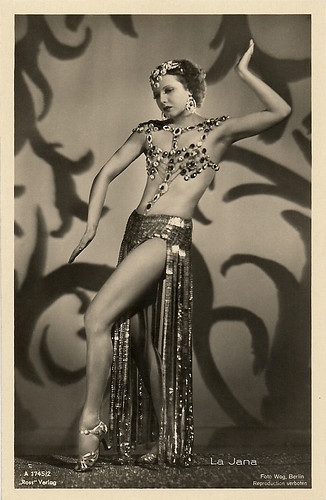
German postcard by Ross Verlag, no. A 1745/2, 1937-1938. Photo: Wog, Berlin. Collection: Didier Hanson.

German postcard by Ross Verlag, no. A 2504/1, 1939-1940. Photo: Tobis. La Jana in Stern von Rio/Star of Rio (Karl Anton, 1940).
La Jana was born as Henriette Margarethe Hiebel in Mauer near Wien (Vienna), Austria-Hungary, in 1905. ‘Henny’ was the second and youngest daughter of Heinrich and Anna Hiebel. Her older sister, Anny, was later trained as an opera singer. Her father was a gild master and the family moved to Frankfurt when Henny was only two years. At the age of eight, she already appeared in the children's ballet of the Frankfurt Opera. Henny completed a dance training at the Opera Ballet in Frankfurt and became a dancer in cabarets and revues. In 1921, she performed her own improvisations in Trude Hesterberg’s cabaret Die wilde Bühne (The Wild Stage).
In Paris, she met Géza von Cziffra, who, according to his autobiography, brought her to Berlin, director Friedrich Zelnik and the cinema. He writes "... And there I saw her dance for the first time: this woman had the most beautiful body I had seen in my life. The girl, that moved here up and down in the stage lights (...) was boyishly built: slim hips, almost only a hint of breasts. She was a simple, friendly, approachable girl but she had as much interest for sex as Immanuel Kant."
There are at least three different versions of the discovery of La Jana. According to contemporary sources, La Jana was discovered in Cabaret Weinklause in Frankfurt by a nightclub owner from Paris and later returned as a dancer to Berlin. Another report says that La Jana was hired overnight as a substitute for Claire Bauroff, the ill star of a Revue in Dresden and that she later also received offers from Berlin.
However, in 1925 she made her first film appearance in Wege zu Kraft und Schönheit - Ein Film über moderne Körperkultur/Ways to Strength and Beauty (Nicholas Kaufmann, Wilhelm Prager, 1925). This film about the ‘modern body culture' was very much an artifact of the Naturist fad that swept Germany at the time. Friedrich Zelnik engaged her for his production company the Deutsche Film Union (Defu), and employed her in silent films like Der Biberpelz/The Beaver Fur (Erich Schönfelder, 1928).
She also appeared in international silent films such as the Danish-German production Die weisse Geisha/The White Geisha (Valdemar Andersen, Karl Heiland, 1926), the Swedish production En perfekt gentleman/A Perfect Gentleman (Vilhelm Bryde, Gösta Ekman, 1927) in which she costarred with Gösta Ekman and Hans Albers, and the French-German-Belgian production Thérèse Raquin/Shadows of Fear (Jacques Feyder, 1928) based on the novel by Émile Zola. La Jana became engaged in 1926 to actor Ulrich Bettac. In that year, she still used her civil name, Henny Hiebel and she moved to Berlin with her fiancé. A few years later, this relationship was resolved.
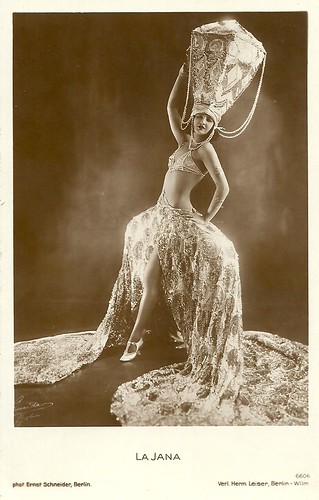
German postcard by Verlag Hermann Leiser, Berlin-Wilm., no. 6606. Photo: Ernst Schneider, Berlin. Collection: Didier Hanson.
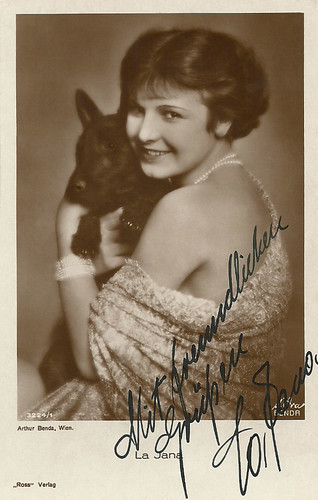
German postcard by Ross Verlag, no. 3224/1, 1928-1929. Photo: Arthur Benda, Wien. Collection: Didier Hanson.
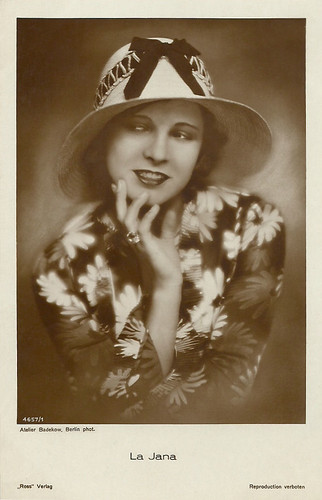
German postcard by Ross Verlag, no. 4657/1, 1929-1930. Photo: Atelier Badekow, Berlin. Collection: Didier Hanson.

German postcard by Ross Verlag, no. 5035/1, 1930-1931. Photo: Atelier Manassé, Wien. Collection: Didier Hanson.

Austrian postcard by Iris-Verlag, no. 5443, 1938-1939. Photo: DEFU / Defina / Verleih Philipp & Co. Collection: Didier Hanson.
La Jana danced in revues in Berlin, Stockholm (1933) and London (1934-1935) and she participated in the shows 'An und Aus' (To and From) by Herman Haller, 'Casanova' by Erik Charell and 'Die schöne Helena' (The beautiful Helen) by Max Reinhardt. In the revue 'Casanova', La Jana was served half-naked, on a silver platter to the audience. The reaction of the public was accordingly: La Jana was the talk of Berlin.
In his autobiography, director Géza von Cziffra claims that La Jana had an affair with Kronprinz Wilhelm (Crown Prince William) but he dismisses rumors about an affair between La Jana and Joseph Goebbels.
The show 'Streamline' by Charles B. Cochran led La Jana in 1934 on a tour throughout England and Scotland. Upon her return to Germany in 1936, she made almost every year one or more films.
The sound film had underlined her dancing in an optimal way with the audible music and she had had success with her appearance in Der Schlemihl/The Unlucky Devil (Max Nosseck, 1931) as a dancer opposite Curt Bois.
The circus drama Truxa (Hans H. Zerlett, 1937) made La Jana in one stroke acquainted all over Germany. At IMDb, Jan Onderwater writes about her performance: "La Jana, here in her first major part, cannot dance but she is not that bad an actress as she is reputed to have been; with her half-naked body she is exotic and lovely to look at."
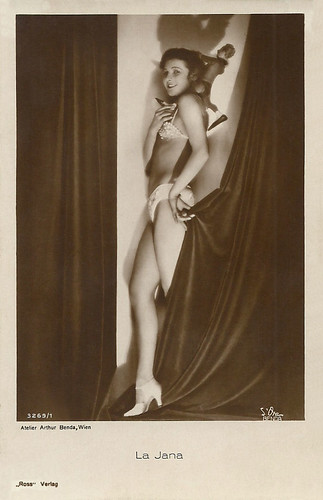
German postcard by Ross Verlag, no. 3269/1, 1928-1929. Photo: Atelier Arthur Benda, Wien. Collection: Didier Hanson.
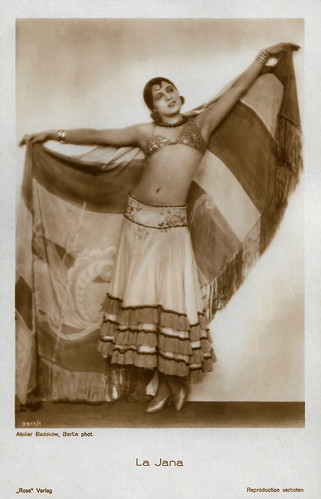
German postcard by Ross Verlag, no. 3911/1, 1928-1929. Photo: Badekow.

German postcard by Ross Verlag, no. 4657/1, 1929-1930. Photo: Atelier Badekow, Berlin.

German postcard by Ross Verlag, no. 4657/2, 1929-1930. Photo: Atelier Badekow, Berlin. Collection: Didier Hanson.

German postcard by Ross Verlag, no. 5485/1, 1930-1931. Photo: Atelier Manassé, Wien. Collection: Didier Hanson.
La Jana travelled to India for the films Der Tiger von Eschnapur/The Tiger of Eschnapur (Richard Eichberg, 1938) and Das indische Grabmal/The Indian Tomb (Richard Eichberg, 1938), co-starring with Frits van Dongen (aka Philip Dorn) and Theo Lingen.
Millions of people admired the exotic magic of the film and La Jana. Filmportal.de analyzes: “Although typifying the embodiment of the ‘non-Aryan’ woman, which clearly contradicted the ideal vision of womanliness of the Third Reich, she became for this same very reason the ideal projection of all the various desires of the public.”
Her next films were the musical Es leuchten die Sterne/The Stars Shine (Hans H. Zerlett, 1938) and the crime film Menschen vom Variete/People from the Music Hall (Josef von Báky, 1939) with Hans Holt.
After she earlier had refused to go, Goebbels forced her on a tour for the Wehrmacht in 1939/1940. Her fame made her a sure crowd-puller. It was a cold winter and she wore little clothes on the stage. She became ill with pneumonia on both lungs in February 1940. On 13 March 1940, La Jana died of pneumonia and pleurisy in a hospital in Berlin. She was only 35 and became a mysterious legend. She was dearly missed at the glamorous world premiere of her last film, Stern von Rio/Star of Rio (Karl Anton, 1940), at the Ufa Palast am Zoo in Berlin.
In 1954, fourteen years after her death, a person appeared who claimed to be La Jana's son. After Anny Bittlinski, La Jana's sister denied his story and he was charged with forgery and fraud. There was also a rumour that La Jana helped Jews escape from Germany. The SS would have killed her for this and the pneumonia story would have been invented to conceal the murder. Another rumour is about her name. ‘La Jana’ is supposed to originate from the Indian language, and to mean ‘The Flower-like’. In fact, La Jana is a purely invented name and has only superficial similarities with words from Sanskrit. How Henny Hiebel came to her artist's name is not recorded. Henny Hiebel and a partner performed for a time under the name The Charming Sisters. There are some Swedish autograph cards of her with the name Lary Jana. The mystery of La Jana remains.

German postcard by Ross Verlag, no. 7417/1, 1932-1933. Photo: Atelier Manassé, Wien.

German postcard by Ross Verlag, no. A 1239/1, 1937-1938. Photo: Ewald / Eichberg-Film. La Jana in Das indische Grabmal/The Indian Tomb (Richard Eichberg, 1938).
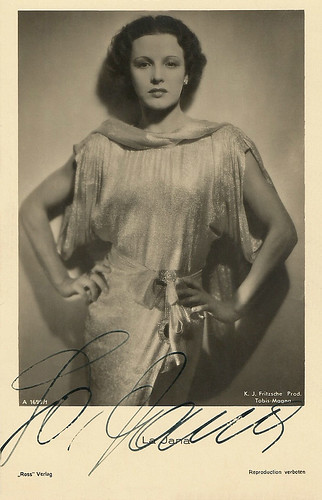
German postcard by Ross Verlag, no. A 1699/1, 1937-1938. Photo: K.J. Fritzsche Prod. / Tobis-Magna. Collection: Didier Hanson.
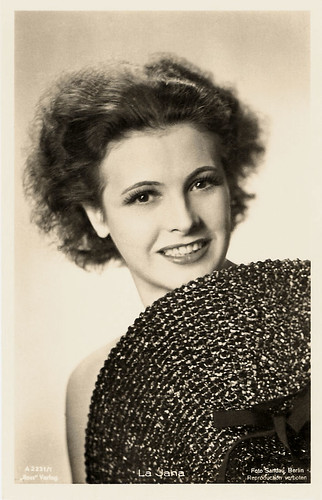
German postcard by Ross Verlag, no. A 2231/1, 1939-1940. Photo: Sandau, Berlin.

German postcard by Ross Verlag, no. A 2248/1, 1939-1940. Photo: Märkische / Panorama / Schneider, Südost. La Jana in Menschen vom Varieté/People from the variety show (Josef von Báky, 1939).
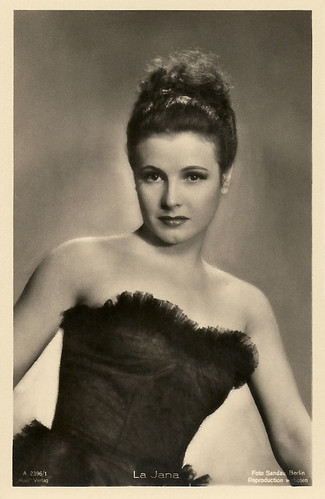
German postcard by Ross Verlag, no. A 2396/1, 1941-1944. Photo: Sandau, Berlin. Collection: Didier Hanson.
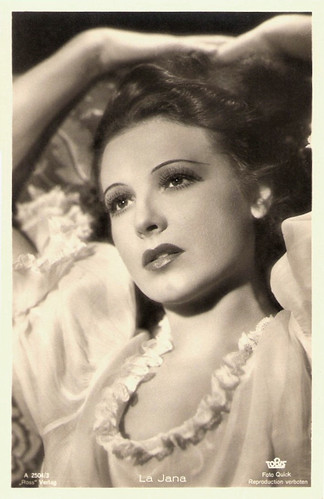
German postcard by Ross Verlag, no. A 2404/3, 1941-1944. Photo: Quick / Tobis.

German postcard by Ross Verlag, no. A 2504/2, 1939-1940. Photo: Quick / Tobis. Collection: Didier Hanson.
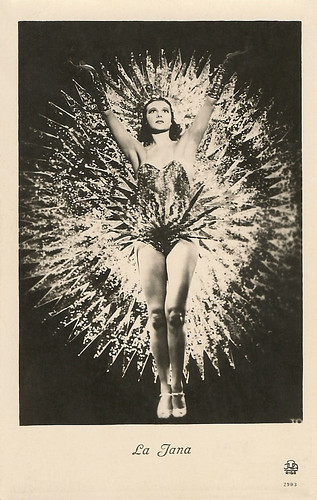
Latvian postcard by JDA, Riga, no. 2503. Photo: Tobis. Collection: Didier Hanson. La Jana in Es leuchten die Sterne/The Stars Shine (Hans H. Zerlett, 1938).
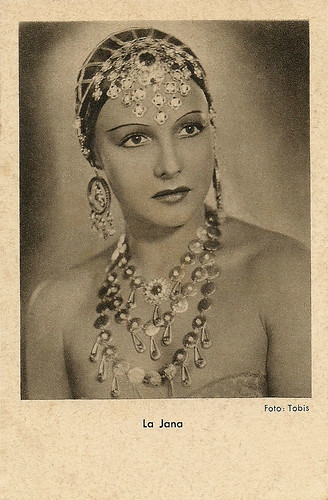
German postcard by Das Programm von Heute / Ross Verlag. Photo: Tobis. Collection: Didier Hanson.

German postcard by Das Programm von Heute / Ross Verlag. Photo: Tobis / Kilian.

German postcard by Das Programm von Heute / Ross Verlag. Photo: Tobis / Quick. Collection: Didier Hanson.
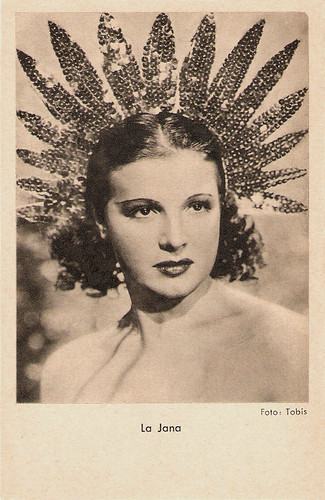
German postcard by Das Programm von Heute / Ross Verlag. Photo: Tobis.

German postcard by Ross Verlag, no. K 1138. Photo: Atelier Binder, Berlin. Collection: Didier Hanson.
Sources: Thomas Staedeli (Cyranos), Jan Onderwater (IMDb), Operator 99 (Allure), Filmportal.de, Wikipedia (German), The Androom Archives, and IMDb.
This post was last updated on 1 February 2025.

German postcard by Ross Verlag, no. A 1910/2, 1937-1938. Photo: Atelier Schneider, Berlin / Tobis.

German postcard by Ross Verlag, no. A 1589/1, 1938-1939. Photo: Eichberg-Film. Collection: Didier Hanson.

German postcard by Ross Verlag, no. A 1590/1, 1937-1938. Photo: Sasha, London. Collection: Didier Hanson.

German postcard by Ross Verlag, no. A 1745/2, 1937-1938. Photo: Wog, Berlin. Collection: Didier Hanson.

German postcard by Ross Verlag, no. A 2504/1, 1939-1940. Photo: Tobis. La Jana in Stern von Rio/Star of Rio (Karl Anton, 1940).
The most beautiful body I had seen in my life
La Jana was born as Henriette Margarethe Hiebel in Mauer near Wien (Vienna), Austria-Hungary, in 1905. ‘Henny’ was the second and youngest daughter of Heinrich and Anna Hiebel. Her older sister, Anny, was later trained as an opera singer. Her father was a gild master and the family moved to Frankfurt when Henny was only two years. At the age of eight, she already appeared in the children's ballet of the Frankfurt Opera. Henny completed a dance training at the Opera Ballet in Frankfurt and became a dancer in cabarets and revues. In 1921, she performed her own improvisations in Trude Hesterberg’s cabaret Die wilde Bühne (The Wild Stage).
In Paris, she met Géza von Cziffra, who, according to his autobiography, brought her to Berlin, director Friedrich Zelnik and the cinema. He writes "... And there I saw her dance for the first time: this woman had the most beautiful body I had seen in my life. The girl, that moved here up and down in the stage lights (...) was boyishly built: slim hips, almost only a hint of breasts. She was a simple, friendly, approachable girl but she had as much interest for sex as Immanuel Kant."
There are at least three different versions of the discovery of La Jana. According to contemporary sources, La Jana was discovered in Cabaret Weinklause in Frankfurt by a nightclub owner from Paris and later returned as a dancer to Berlin. Another report says that La Jana was hired overnight as a substitute for Claire Bauroff, the ill star of a Revue in Dresden and that she later also received offers from Berlin.
However, in 1925 she made her first film appearance in Wege zu Kraft und Schönheit - Ein Film über moderne Körperkultur/Ways to Strength and Beauty (Nicholas Kaufmann, Wilhelm Prager, 1925). This film about the ‘modern body culture' was very much an artifact of the Naturist fad that swept Germany at the time. Friedrich Zelnik engaged her for his production company the Deutsche Film Union (Defu), and employed her in silent films like Der Biberpelz/The Beaver Fur (Erich Schönfelder, 1928).
She also appeared in international silent films such as the Danish-German production Die weisse Geisha/The White Geisha (Valdemar Andersen, Karl Heiland, 1926), the Swedish production En perfekt gentleman/A Perfect Gentleman (Vilhelm Bryde, Gösta Ekman, 1927) in which she costarred with Gösta Ekman and Hans Albers, and the French-German-Belgian production Thérèse Raquin/Shadows of Fear (Jacques Feyder, 1928) based on the novel by Émile Zola. La Jana became engaged in 1926 to actor Ulrich Bettac. In that year, she still used her civil name, Henny Hiebel and she moved to Berlin with her fiancé. A few years later, this relationship was resolved.

German postcard by Verlag Hermann Leiser, Berlin-Wilm., no. 6606. Photo: Ernst Schneider, Berlin. Collection: Didier Hanson.

German postcard by Ross Verlag, no. 3224/1, 1928-1929. Photo: Arthur Benda, Wien. Collection: Didier Hanson.

German postcard by Ross Verlag, no. 4657/1, 1929-1930. Photo: Atelier Badekow, Berlin. Collection: Didier Hanson.

German postcard by Ross Verlag, no. 5035/1, 1930-1931. Photo: Atelier Manassé, Wien. Collection: Didier Hanson.

Austrian postcard by Iris-Verlag, no. 5443, 1938-1939. Photo: DEFU / Defina / Verleih Philipp & Co. Collection: Didier Hanson.
Served half naked, on a silver platter
La Jana danced in revues in Berlin, Stockholm (1933) and London (1934-1935) and she participated in the shows 'An und Aus' (To and From) by Herman Haller, 'Casanova' by Erik Charell and 'Die schöne Helena' (The beautiful Helen) by Max Reinhardt. In the revue 'Casanova', La Jana was served half-naked, on a silver platter to the audience. The reaction of the public was accordingly: La Jana was the talk of Berlin.
In his autobiography, director Géza von Cziffra claims that La Jana had an affair with Kronprinz Wilhelm (Crown Prince William) but he dismisses rumors about an affair between La Jana and Joseph Goebbels.
The show 'Streamline' by Charles B. Cochran led La Jana in 1934 on a tour throughout England and Scotland. Upon her return to Germany in 1936, she made almost every year one or more films.
The sound film had underlined her dancing in an optimal way with the audible music and she had had success with her appearance in Der Schlemihl/The Unlucky Devil (Max Nosseck, 1931) as a dancer opposite Curt Bois.
The circus drama Truxa (Hans H. Zerlett, 1937) made La Jana in one stroke acquainted all over Germany. At IMDb, Jan Onderwater writes about her performance: "La Jana, here in her first major part, cannot dance but she is not that bad an actress as she is reputed to have been; with her half-naked body she is exotic and lovely to look at."

German postcard by Ross Verlag, no. 3269/1, 1928-1929. Photo: Atelier Arthur Benda, Wien. Collection: Didier Hanson.

German postcard by Ross Verlag, no. 3911/1, 1928-1929. Photo: Badekow.

German postcard by Ross Verlag, no. 4657/1, 1929-1930. Photo: Atelier Badekow, Berlin.

German postcard by Ross Verlag, no. 4657/2, 1929-1930. Photo: Atelier Badekow, Berlin. Collection: Didier Hanson.

German postcard by Ross Verlag, no. 5485/1, 1930-1931. Photo: Atelier Manassé, Wien. Collection: Didier Hanson.
Contradicting the ideal vision of womanliness of the Third Reich
La Jana travelled to India for the films Der Tiger von Eschnapur/The Tiger of Eschnapur (Richard Eichberg, 1938) and Das indische Grabmal/The Indian Tomb (Richard Eichberg, 1938), co-starring with Frits van Dongen (aka Philip Dorn) and Theo Lingen.
Millions of people admired the exotic magic of the film and La Jana. Filmportal.de analyzes: “Although typifying the embodiment of the ‘non-Aryan’ woman, which clearly contradicted the ideal vision of womanliness of the Third Reich, she became for this same very reason the ideal projection of all the various desires of the public.”
Her next films were the musical Es leuchten die Sterne/The Stars Shine (Hans H. Zerlett, 1938) and the crime film Menschen vom Variete/People from the Music Hall (Josef von Báky, 1939) with Hans Holt.
After she earlier had refused to go, Goebbels forced her on a tour for the Wehrmacht in 1939/1940. Her fame made her a sure crowd-puller. It was a cold winter and she wore little clothes on the stage. She became ill with pneumonia on both lungs in February 1940. On 13 March 1940, La Jana died of pneumonia and pleurisy in a hospital in Berlin. She was only 35 and became a mysterious legend. She was dearly missed at the glamorous world premiere of her last film, Stern von Rio/Star of Rio (Karl Anton, 1940), at the Ufa Palast am Zoo in Berlin.
In 1954, fourteen years after her death, a person appeared who claimed to be La Jana's son. After Anny Bittlinski, La Jana's sister denied his story and he was charged with forgery and fraud. There was also a rumour that La Jana helped Jews escape from Germany. The SS would have killed her for this and the pneumonia story would have been invented to conceal the murder. Another rumour is about her name. ‘La Jana’ is supposed to originate from the Indian language, and to mean ‘The Flower-like’. In fact, La Jana is a purely invented name and has only superficial similarities with words from Sanskrit. How Henny Hiebel came to her artist's name is not recorded. Henny Hiebel and a partner performed for a time under the name The Charming Sisters. There are some Swedish autograph cards of her with the name Lary Jana. The mystery of La Jana remains.

German postcard by Ross Verlag, no. 7417/1, 1932-1933. Photo: Atelier Manassé, Wien.

German postcard by Ross Verlag, no. A 1239/1, 1937-1938. Photo: Ewald / Eichberg-Film. La Jana in Das indische Grabmal/The Indian Tomb (Richard Eichberg, 1938).

German postcard by Ross Verlag, no. A 1699/1, 1937-1938. Photo: K.J. Fritzsche Prod. / Tobis-Magna. Collection: Didier Hanson.

German postcard by Ross Verlag, no. A 2231/1, 1939-1940. Photo: Sandau, Berlin.

German postcard by Ross Verlag, no. A 2248/1, 1939-1940. Photo: Märkische / Panorama / Schneider, Südost. La Jana in Menschen vom Varieté/People from the variety show (Josef von Báky, 1939).

German postcard by Ross Verlag, no. A 2396/1, 1941-1944. Photo: Sandau, Berlin. Collection: Didier Hanson.

German postcard by Ross Verlag, no. A 2404/3, 1941-1944. Photo: Quick / Tobis.

German postcard by Ross Verlag, no. A 2504/2, 1939-1940. Photo: Quick / Tobis. Collection: Didier Hanson.

Latvian postcard by JDA, Riga, no. 2503. Photo: Tobis. Collection: Didier Hanson. La Jana in Es leuchten die Sterne/The Stars Shine (Hans H. Zerlett, 1938).

German postcard by Das Programm von Heute / Ross Verlag. Photo: Tobis. Collection: Didier Hanson.

German postcard by Das Programm von Heute / Ross Verlag. Photo: Tobis / Kilian.

German postcard by Das Programm von Heute / Ross Verlag. Photo: Tobis / Quick. Collection: Didier Hanson.

German postcard by Das Programm von Heute / Ross Verlag. Photo: Tobis.

German postcard by Ross Verlag, no. K 1138. Photo: Atelier Binder, Berlin. Collection: Didier Hanson.
Sources: Thomas Staedeli (Cyranos), Jan Onderwater (IMDb), Operator 99 (Allure), Filmportal.de, Wikipedia (German), The Androom Archives, and IMDb.
This post was last updated on 1 February 2025.
No comments:
Post a Comment